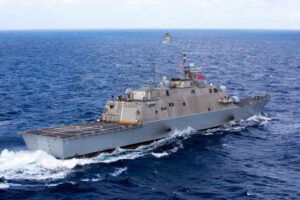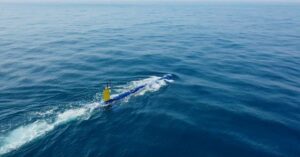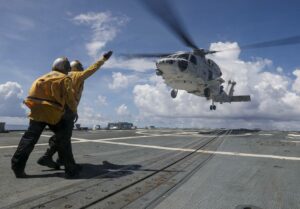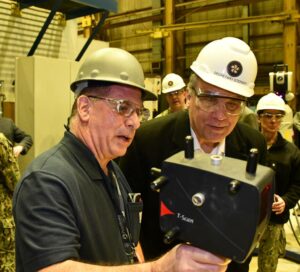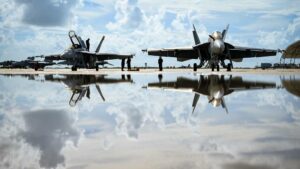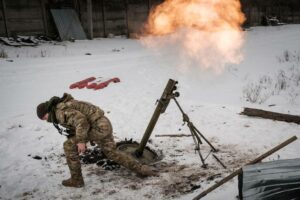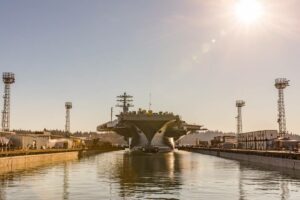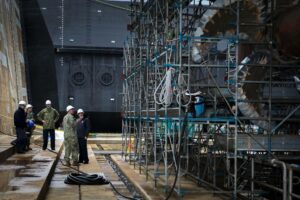WASHINGTON — The head of U.S. Naval Surface Forces and other brass have praised the work of Navy destroyers operating in the Red Sea, where they have since October shot down scores of attack drones and missiles fired by Iran-backed Houthi rebels in Yemen.
But applause from Vice Adm. Brendan McLane and other leaders has been paired with frustrations that warships like the Carney, Gravely, Mason, Laboon and Thomas Hudner are fighting without a potential key asset: the long-planned and ever-elusive laser.
High-energy lasers, or HELs, and high-power microwaves, or HPMs, would offer the surface fleet another weapon for countering overhead threats, including unmanned aerial vehicles and rockets. Despite decades of research and development and billions of dollars spent for a threat like the one the Navy now faces in the Red Sea, such systems have yet to enter the surface fleet and broader military in a meaningful way, according to outside analysts and service leaders.
McLane called the glacial development pace “frustrating” in a call with reporters this month.
“When I was in Bahrain as [the Destroyer Squadron 50 commanding officer] 10 years ago, the afloat staging base USS Ponce had a laser on it,” McLane told reporters ahead of the Surface Navy Association conference this month. “We’re 10 years down the road and we still don’t have something we can field?”
RELATED
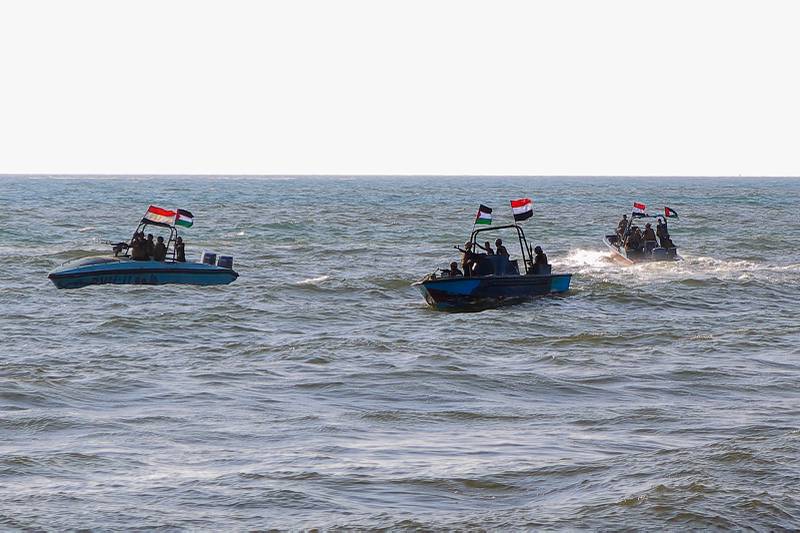
To date, only a smattering of ships have laser capabilities onboard. Few directed-energy tools have made the successful leap from science fiction to real life, with outside experts and government reviews saying the development of such futuristic weaponry is as challenging as it is worthwhile and potentially game-changing.
Directed energy could complement the panoply of weapons a U.S. destroyer in the Red Sea has at the ready, and their widespread fielding would signal a revolution in military affairs on the level of fighter jets and missiles, according to analysts.
McLane suggested that lasers, including today’s versions, would be helpful in batting down Houthi bombardments.
“Against some of the targets that have been shot, some of the systems that we have can be effective,” he said.
Directed energy could also help crews conserve finite munitions supplies while on station, analysts say. The 60-plus confirmed intercepts of drones and missiles hurtling toward Navy ships and commercial vessels in the Red Sea have largely relied on the Standard Missile-2, or SM-2, although service officials have declined to say precisely what has been fired in each engagement.
‘The way of the future’
The Department of Defense is spending on average $1 billion annually to develop HEL and HPM weapons, with the goal of deploying them aboard ground vehicles, aircraft and ships. It requested at least $669 million in fiscal 2023 for unclassified research, testing and evaluation, and another $345 million for unclassified procurement.
But bridging the so-called valley of death — the stubborn lag between private development and military procurement and implementation — has proved difficult, according to the Government Accountability Office. The Defense Department has struggled to get “these technologies out of the lab and into the field” for a number of reasons, including how, exactly, to use them during missions, according to an April report by the federal watchdog.
“Without early transition planning and drafting transition agreements, the Navy risks developing technology that is misaligned with operational needs,” the report warned.
Outside analysts note that developing such capabilities is not easy.
The full realization of fielded directed-energy weapons is “something of a holy grail,” according to Eric Wertheim, an author, defense consult and U.S. Naval Institute columnist.
The lack of HEL or HPM systems aboard ships is less of an acquisitions fail, he said, and more of a hardware-and-software jigsaw puzzle to solve.
Finding a power source for the directed-energy weapons and space for such systems onboard a ship already full of energy-hungry sensors and combat management systems is a serious roadblock, he said.
While lasers can punch holes through a variety of material, certain atmospheric conditions, such as fog or wind, can impede or distort the shot. High-power microwaves can have near-instant frying effects on electronic guts, but they’re less effective at greater ranges.
RELATED

“It’s incredibly challenging technologically, and the technology is always a step, or a few steps, away from where we would like it to be,” Wertheim said in an interview. “We’re pushing the barriers, in many ways, along with our allies, and I think that our adversaries are very focused on overwhelming the defenses, as you see in the Red Sea right now.”
Both Lockheed Martin’s High Energy Laser with Integrated Optical-dazzler and Surveillance, or HELIOS, and the Navy’s own Optical Dazzling Interdictor Navy, or ODIN, have been installed aboard destroyers. The former was specifically designed to interdict drones and small, agile boats, the kind of threats with which Houthi militants are peppering shipping channels.
Navy Secretary Carlos Del Toro told reporters at the SNA conference that he understood McLane’s vexation. He also said the HELIOS system, installed on the destroyer Preble in 2022, is now “a bit beyond” the experimentation phase and primed for growth.
“This is the way of the future,” Del Toro said, “and we are going to be looking in the fiscal years ‘26, ‘27 and into the [five-year] future years defense program on how to accelerate deployment of HELIOS and HELIOS-like capabilities on our DDG-51 platforms.”
The Navy tested an HEL on another type of vessel, the San Antonio-class Portland, in 2020 and 2021. The ship has more available power to support larger laser weapons, and went on to disable targets in the Pacific Ocean and Gulf of Aden, the service said.
The good, the bad and the trade-offs
Laser and microwave setups have their respective strengths and weaknesses.
Neither needs to be mechanically reloaded like a rifle or a tank — particularly important in a wartime scenario, when Navy resupply lines would be threatened.
They do have limits, however.
“Lasers are pretty effective, but they take time,” Bryan Clark, a senior fellow and director of the Center for Defense Concepts and Technology at the Hudson Institute think tank, said in an interview. “You’ve got to have the laser shoot the drone for several seconds, which means it can only shoot one at a time.”
To be successful, especially in a swarm scenario with multiple kinds of threats overhead, Clark said, a ship’s sensors would have to differentiate between higher-end targets that demand a kinetic hit and lower-end targets that a laser can manage. The crew aboard the Carney in December intercepted more than a dozen drones that U.S. Central Command described as a “wave” originating from Yemen.
“I want to use an SM-2 to shoot down the C-802 or maybe a bigger, more-dangerous drone,” said Clark, who in years past served as a special assistant to the chief of naval operations. “But I don’t want to use an SM-2 to shoot down smaller, less-capable drones.”
RELATED

Dispatching one-way attack drones that often utilize cheap, off-the-shelf parts presents an uncomfortable cost-benefit analysis for the Navy. Sophisticated interceptors used by the U.S. can cost millions of dollars each, while a Houthi drone furnished by Iran, like the Shahed and its derivatives, can cost a few thousand.
The French navy has defended its use of Aster 15 missiles to take down unmanned aerial vehicles, saying what mattered was not the cost of the ordnance but rather the value of ships and people saved from the attack. A ship’s captain must be free to use whichever weapons allow them to keep their ship and crew safe, multiple retired surface warfare officers told Navy Times.
Munitions and more
Striking a balance between traditional stockpiles and novel technologies like lasers or microwaves will be key going forward.
Military officials and outside observers see directed energy as a card in the deck of defenses. They can save resources and reduce strain on munitions manufacturers. But fielding such futuristic systems will require buy-in by fleet commanders who are used to the tried-and-true conventional arms they have handled for years.
“The threat is constantly adapting. There are some threats that lasers are very well-suited for, and some you might want to have more hard-kill missile defense,” Wertheim said. “We’re going to have a layered defense that will, hopefully, include directed energy, and I think we’re seeing that. The directed energy percentage will increase over time.”
“There are going to be situations where you can’t shoot the archer, so to speak,” he added. “That’s always the optimal solution — take out the launchers before they launch. But when you can’t do that, then directed energy has potential.”
The Navy understands the need to increase its inventory of “all munitions” and is attempting to do so with industry assistance, according to Rear Adm. Fred Pyle, the director of surface warfare on the chief of naval operations’ staff.
The service at the same time is on the lookout for “cost-effective ways to neutralize threats,” he said at the SNA conference.
The Navy’s fiscal 2024 budget blueprint, totaling $255.8 billion, up 4.5% from the year prior, backed multi-year procurements for four long-range weapons: the Standard Missile, the Naval Strike Missile, the Long-Range Anti-Ship Missile and the Advanced Medium-Range Air-to-Air Missile.
Firing a directed-energy weapon is advertised as costing pennies to the dollar when compared to a missile or other traditional weapon. The DragonFire laser, developed by British industry and government, costs no more than £10, or $13, a shot.
But tapping contractors to build laser or microwave systems, installing them aboard ships, training crews to use them and operating them is less cut and dry.
“We continue to invest in directed-energy capability — it’s hard,” said Pyle, who helps shepherd money for the development and purchase of new ships and their weapons.
“SWO Boss [McLane] has talked about this. We’re still working on that technology,” he added. “It requires space, weight, power and cooling, which can be a challenge on our current surface combatants.”
Colin Demarest is a reporter at C4ISRNET, where he covers military networks, cyber and IT. Colin previously covered the Department of Energy and its National Nuclear Security Administration — namely Cold War cleanup and nuclear weapons development — for a daily newspaper in South Carolina. Colin is also an award-winning photographer.
Megan Eckstein is the naval warfare reporter at Defense News. She has covered military news since 2009, with a focus on U.S. Navy and Marine Corps operations, acquisition programs and budgets. She has reported from four geographic fleets and is happiest when she’s filing stories from a ship. Megan is a University of Maryland alumna.
Geoff is the editor of Navy Times, but he still loves writing stories. He covered Iraq and Afghanistan extensively and was a reporter at the Chicago Tribune. He welcomes any and all kinds of tips at geoffz@militarytimes.com.
- SEO Powered Content & PR Distribution. Get Amplified Today.
- PlatoData.Network Vertical Generative Ai. Empower Yourself. Access Here.
- PlatoAiStream. Web3 Intelligence. Knowledge Amplified. Access Here.
- PlatoESG. Carbon, CleanTech, Energy, Environment, Solar, Waste Management. Access Here.
- PlatoHealth. Biotech and Clinical Trials Intelligence. Access Here.
- Source: https://www.defensenews.com/news/your-navy/2024/01/22/the-us-navy-could-use-some-lasers-on-its-surface-fleet-right-now/
- :has
- :is
- :not
- :where
- $1 billion
- 1
- 10
- 14
- 15%
- 19
- 2014
- 2020
- 2021
- 2022
- 2023
- 2024
- 22
- 2nd
- 50
- 70
- 8
- a
- Aaron
- About
- accelerate
- According
- accountability
- acquisition
- acquisitions
- added
- administration
- advanced
- Affairs
- Affiliated
- AFGHANISTAN
- agile
- ago
- agreements
- ahead
- air-to-air
- aircraft
- All
- allow
- along
- already
- also
- Although
- always
- Amid
- an
- analysis
- Analysts
- and
- Annually
- Another
- any
- Applause
- April
- archer
- ARE
- arms
- AS
- ask
- asset
- Assistance
- Assistant
- Association
- At
- atmospheric
- attack
- attempting
- author
- available
- average
- award-winning
- away
- Bad
- bahrain
- Balance
- barriers
- base
- BE
- been
- before
- between
- bigger
- Billion
- billions
- Bit
- blueprint
- BOSS
- brass
- bridging
- British
- broader
- Bryan
- budget
- Budgets
- build
- but
- by
- call
- called
- CAN
- capabilities
- capability
- card
- Carolina
- Center
- central
- certain
- challenge
- challenging
- channels
- cheap
- chicago
- chief
- City
- class
- Coast
- cold
- COM
- combat
- commercial
- Communication
- compared
- Complement
- concepts
- conditions
- Conference
- CONFIRMED
- constantly
- continue
- contractors
- conventional
- Cost
- Costs
- could
- countering
- covered
- covers
- crew
- Current
- Cut
- cyber
- daily
- Date
- dec
- decades
- December
- deck
- Defense
- Defense Department
- del
- Demand
- Department
- department of defense
- Department of Energy
- deploying
- deployment
- Derivatives
- described
- designed
- Despite
- develop
- developed
- developing
- Development
- differentiate
- difficult
- directed
- Director
- do
- Dock
- Dollar
- dollars
- Dont
- down
- dozen
- drone
- Drones
- dry
- during
- each
- Early
- easy
- editor
- Effective
- effects
- Electronic
- energy
- engagement
- Enter
- eric
- especially
- Ether (ETH)
- evaluation
- exactly
- experts
- extensively
- faces
- FAIL
- false
- Federal
- fellow
- few
- Fiction
- field
- fighting
- Filing
- fired
- fires
- Fiscal
- FLEET
- floating
- Focus
- focused
- Fog
- For
- Forces
- Former
- Forward
- four
- Free
- French
- from
- Frustrations
- full
- furnished
- future
- futuristic
- geographic
- get
- goal
- going
- good
- got
- Government
- Government Accountability Office
- Grail
- greater
- Ground
- Group
- Growth
- Guard
- gulf
- had
- Hard
- Have
- he
- head
- help
- helpful
- helps
- High
- Hit
- Holes
- Hopefully
- How
- How To
- However
- http
- HTTPS
- i
- image
- images
- implementation
- important
- in
- include
- Including
- Increase
- incredibly
- industry
- installing
- Institute
- integrated
- Interview
- into
- inventory
- Invest
- Iran
- iraq
- IT
- ITS
- Jan
- Jets
- jigsaw
- jpg
- Keep
- Key
- Kind
- lab
- Lack
- largely
- larger
- laser
- lasers
- launch
- layered
- leaders
- Leap
- least
- less
- Level
- Life
- like
- limits
- looking
- loves
- made
- manage
- management
- Manufacturers
- many
- March
- Marine
- Maryland
- Mason
- Mass
- material
- maybe
- meaningful
- means
- Megan
- Members
- might
- Military
- million
- millions
- missiles
- missions
- money
- Month
- more
- multi-year
- multiple
- must
- namely
- National
- Need
- needs
- networks
- New
- news
- no
- note
- now
- nuclear
- Nuclear weapons
- number
- observers
- ocean
- Oct
- october
- of
- offer
- Office
- Officer
- officers
- officials
- often
- on
- Onboard
- ONE
- only
- operating
- operational
- Operations
- optimal
- or
- originating
- Other
- our
- out
- outside
- over
- overwhelming
- own
- Pace
- Pacific
- Pacific Ocean
- paired
- particularly
- parts
- past
- People
- percentage
- phase
- photo
- photographer
- planning
- Platforms
- plato
- Plato Data Intelligence
- PlatoData
- Portland
- potential
- potentially
- power
- Praised
- precisely
- presents
- pretty
- previously
- Prior
- private
- procurement
- Program
- Programs
- proved
- punch
- purchase
- Pushing
- puzzle
- ranges
- rather
- ready
- real
- real life
- realization
- reasons
- Red
- reduce
- report
- Reported
- reporter
- requested
- require
- requires
- research
- research and development
- Resources
- respective
- Reviews
- Revolution
- right
- risks
- road
- s
- safe
- Said
- same
- San
- Save
- saved
- say
- saying
- scenario
- Science
- Science Fiction
- scores
- Screen
- SEA
- seconds
- secretary
- security
- see
- seeing
- senior
- sensors
- serious
- served
- service
- several
- she
- ship
- Shipping
- ships
- Shoot
- shot
- Signal
- since
- situations
- small
- smaller
- So
- solution
- SOLVE
- some
- something
- sophisticated
- Source
- South
- South carolina
- Space
- speak
- special
- specialist
- specifically
- Spending
- spent
- Staff
- staging
- standard
- station
- Step
- Steps
- Still
- Stories
- strengths
- strike
- successful
- such
- support
- Surface
- surveillance
- Swarm
- system
- Systems
- Take
- tank
- tapping
- Target
- targets
- Technologies
- Technology
- tested
- Testing
- than
- that
- The
- The Future
- their
- Them
- then
- There.
- they
- think
- think tank
- this
- thousand
- threat
- threats
- Through
- time
- times
- tips
- to
- today’s
- told
- tools
- totaling
- toward
- traditional
- Training
- transition
- transport
- type
- u.s.
- U.S. Navy
- understands
- understood
- university
- University of Maryland
- use
- used
- utilize
- value
- variety
- Vehicles
- very
- Vessel
- vessels
- want
- war
- warned
- was
- watchdog
- Way..
- ways
- we
- weaknesses
- Weapons
- weight
- Welcomes
- went
- What
- when
- which
- while
- WHO
- widespread
- will
- wind
- with
- without
- Work
- working
- worthwhile
- would
- writing
- year
- years
- yet
- you
- zephyrnet

